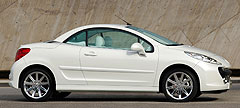Future models - Peugeot - 207 - CCFirst look: Peugeot 207 flips its lidPure design: The all-white Epure is almost production ready. Peugeot makes it crystal clear: the 207 Epure concept heralds its next-gen 207 CC12 Sep 2006 PEUGEOT'S redesigned 207 hatch hasn't even been released in Europe yet but that hasn't stopped Peugeot previewing the all-new coupe-convertible version ahead of its debut in concept guise at this month’s Paris motor show. Dubbed 207 Epure, the 207 CC concept is déjà vu for those at the 1998 Geneva motor show who witnessed the reveal of the 207 concept, which formed the basis of the 206 CC production car that was launched in Europe in early 2001. Similarly, Peugeot freely admits the 207 Epure is "a glimpse of a future 207 model" – even before a successor for the three and five-door 206 goes on sale. That will happen in Europe this month, with 207 hatch sales due to start in Australia early next year. When the 207 CC becomes a production reality some time next year, it’s expected to follow in the footsteps of its popular predecessor by offering a folding metal roof. Key dimensions include a length of 4037mm, width of 1749mm and a height of 1387mm –making it slightly longer, wider and lower than the 207 hatch, with which it shares its 2540mm wheelbase. Epure's kerb weight is listed as 1550kg. However, the 207 Epure’s cutting-edge drivetain makes Peugeot's latest concept more than just a preview of the 207 CC. Epure is powered by a combination of an electric motor and an experimental 20kW fuel cell co-developed by the PSA Peugeot Citroen Group and the French Atomic Energy Commission (AEC), known as "Genepac 20".  According to Peugeot, electricity produced by the fuel cell is used to provide extra power and operating range to the vehicle’s electric motor or its lithium-ion battery. The company says it’s good a top speed of 130km/h, 0-100km/h acceleration in 15 seconds and a range of around 350km. According to Peugeot, electricity produced by the fuel cell is used to provide extra power and operating range to the vehicle’s electric motor or its lithium-ion battery. The company says it’s good a top speed of 130km/h, 0-100km/h acceleration in 15 seconds and a range of around 350km.Painted white and trimmed in white leather to represent "the purity of the concept car’s lines while strengthening the ecological credentials of the technology that powers it", 207 Epure aims to combine zero emissions and silent operation with open-top driving pleasure. The instrument panel features a colour multi-function screen that displays battery charge levels, the quantity of stored hydrogen onboard and the flow of power between electric motor, battery and fuel cell. Peugeot stresses that in the interests of consuming less energy and reducing CO2 emissions it continues to develop more efficient internal combustion engines, including HDi turbo-diesels that employ the PSA Group’s DPFS diesel particulate filter system, engines that run on fuels incorporating biofuels and HDi Hybrid drive systems. Longer term, however, Peugeot says hydrogen fuel cell power has the highest potential as a large-scale energy source for the future – if a number of technical and economic challenges can be overcome. To this end, PSA says its research strategy is to develop a number of fuel cell demonstrators that explore different solutions, including the Peugeot Taxi PAC, a "21st century London taxi" in which hydrogen is stored in the form of compressed gas (300 bar) in a rack of removable cylinders. Then there's the Peugeot H2O, which addresses hydrogen storage issues by producing it on demand on the vehicle itself by means of an aqueous solution of sodium borohydride. Finally, the Peugeot Quark is a futuristic two-seater quad featuring a fuel cell cooled by air and hydrogen that's stored in a single "plug & drive" cylinder at a pressure of 700 bar to increase vehicle range over a pressure of 350 bar. Instead of a single electric motor, the Quark has four electric motors located in each of its wheels. |
Click to sharePeugeot modelsResearch Peugeot Motor industry news |














Facebook Twitter Instagram